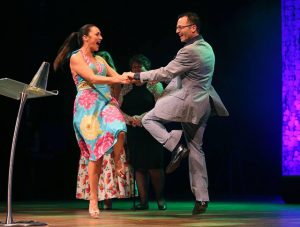Originally Published in the April 2014 Entertainment Guide

Basket Ball. Yes, two separate words, so chosen because a janitor showed up with two peach baskets when James Naismith, instructor at the International Young Men’s Christian Association Training School in Springfield, Mass., asked for two boxes. They were used as goals for the new game he had invented to keep restless male students engaged in indoor exercise during the inclement New England winter. The baskets were attached to opposite gallery railings of the gym and on Dec. 21, 1891, the very first game of basket ball was played with a soccer ball tossed by two nine-men teams (no dribbling allowed). Naismith recalled, “Most of the fouls were called for running with the ball, though tackling the man with the ball was not uncommon.” The ball was fished out of the basket after each score. Among the participants in this first game was Naismith’s friend and roommate, Max J. Exner.
Exner moved to Northfield in the fall of 1892 to continue his studies and to join his athletically inclined older brother Franz at Carleton College. Max Exner was also hired as the first “physical culture” instructor of men and women because of his two years of pre-med physical education work in Springfield. That first winter, Exner introduced the new game of basket ball to his female students. The women at Carleton were already accustomed to marching exercises and some work with dumbbells, bar-bells, club swinging and the like. They took to this interactive game immediately, though they were forced to play in a lower gymnasium room of the Gridley Hall women’s dorm which was only 30 feet by 36 feet with poor ventilation.
The Algol yearbook covering 1892-1893 summed up the experience: “…you should have seen the fun. See the ladies on the floor, attired in loose dresses permitting free action of the body and tennis slippers upon their feet. They are divided into two sides, standing at opposite sides of the gymnasium; their eyes sparkling with excitement, ready to dash at the ball when put into play.” Each individual player “dashes to obtain the ball, now darts to obstruct an opponent and again to protect the goal; running, dodging, squirming,” while “exercising her vocal organs to the best of her ability.” The writer concludes, “Are girls fit for the drawing room only? Can they participate in active games as boys can? Were you permitted to witness one of these games you would surely conclude that they can.”
In recognition of Carleton women having been the first collegians to ever play “basket ball” in Minnesota, the Minnesota High School Girls Basketball 2014 All-Star Series will be held this year at Carleton’s West Gym on April 26. (See accompanying story by Mitchell Rennie.) The Northfield YMCA will also be honoring the Exner family legacy in the new Y Community Center which is due to open this fall. In addition, there is a display of the history of women’s basketball at the Northfield Historical Society through early June.
While Max Exner’s role in promoting basketball is noteworthy, his entire life was one of accomplishment. Exner was born in the tiny village of Volkendorf in the Sudeten Mountains of old Austria on March 31, 1871. At the age of 11, he moved with his family to Boone, Iowa, where he was soon taught his father’s shoemaking trade. He showed an early interest in athletics by joining the German gymnastics club (Turnverein) in town. At the age of 16, he answered an ad for a brewer’s helper in Astoria, Oregon, worked for a time in a bakery, then moved to Seattle where he ended up leading a crew of men in the lumbering business.
Exner’s membership in the YMCA and participation on the association’s gymnastics exhibition team out west sparked his desire to combine spiritual values with physical education and led to his enrollment in 1890 at the YMCA International Training School (now Springfield College) in Massachusetts. His wife, Elizabeth Wells Exner, later wrote, “He came to know what he wanted to do with his life: give it in Christian service to his fellowmen. He never deviated from that course.”

At Carleton, Exner organized many sports and taught compulsory gymnastics, both light (marching and swinging of arms and clubs) and heavy (tumbling, weight-lifting, rings, parallel bars and side horses). His brother Franz, a gymnast who had initiated gymnastic classes prior to Max’s arrival, now aided Max. Both brothers played on the fledgling “foot ball” team which Max captained and coached. Max brought skills from having played quarterback on the team in Springfield led by Amos Alonzo Stagg. (Stagg became the legendary coach of renowned Univ. of Chicago teams, with a record which includes an upset loss to a lightly regarded Carleton team in 1915.) Max also introduced fencing to both sexes at Carleton and his gym teams were soon giving demonstrations at home and in nearby communities. The March 8, 1895, home exhibition showed off 13 events, including a hoop drill and marching exercise by the ladies. The Carletonia of March 12 commended Exner for the “vim and precision” of all classes and proclaimed “Gabriel has blown his trumpet over the grave of our Athletic Association and that body has thrown off its grave clothes and come forth to claim its inheritance.”
Just prior to Max Exner’s graduation from Carleton in 1898, he participated in the state oratorical contest held at Carleton which, according to the April 1st Carletonia, “brought about 300 howling students from the visiting institutions.” Exner’s oration on “Science and Mystery,” showing the relationship between science and religion, received first place in “thought and composition.”
In addition to teaching Carleton women “basket ball,” Exner instructed both men and women in gymnastics. He is shown here with his 1893 women’s gymnastics class, with wands and Indian clubs. Courtesy of Carleton College Archives.
Exner achieved for himself the goal he had once set forth in a Carletonia article in May of 1896. He hoped that Carleton graduates would “leave with the physical, intellectual and spiritual phases of their natures developed in harmonious proportion.”
Exner was now ready to make his mark on the world stage. His brother Franz went on to achievements of his own. After earning a Ph.D. in chemistry at the Univ. of Penn., Franz became a well-respected chemistry professor for 36 years at Carleton and a pioneer in the development of the local Boy Scouts. He lived in Northfield until his death on May 27, 1950. All six of his children with wife Hannah were Carleton alumni.
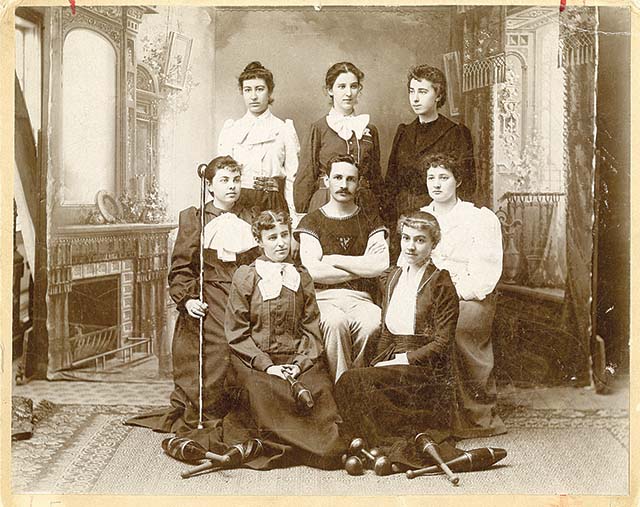
On May 26, 1900, after working at YMCAs in Fitchburg, Mass., and Troy, N.Y., Max Exner, at age 29, married 23-year-old former Carleton student Elizabeth Wells. She wrote she had first been impressed by seeing this older man lead a Grand March which opened the Spring Reception, “Carleton’s nearest approach to dancing!” The couple moved to Kansas City. As Physical Director of the YMCA, he built up a successful athletic program there while earning a medical degree at Kansas City University Medical College.
In 1908, the International Committee of the YMCA asked Exner to become Physical Director of the Central Chinese YMCA in Shanghai, China, to develop an athletic program and train Chinese physical directors. Exner’s wife wrote, “It was a joy for him to accept, for he had long wanted to serve the foreign field.”
This is the earliest photo of Carleton women “basket ball” players, from 1903, after Exner had moved on to earn a medical degree and build up athletics as Physical Director of the YMCA in Kansas City. Courtesy of Carleton College Archives.

In a report dated March 29, 1909, Exner wrote that the indoor gymnastic work he was introducing had found a “ready response.” The long pigtails worn by the men, however, were “not convenient appendages” in the gym. “Vicious jerks of the head” resulted from the pigtails being caught on something or stepped upon, so that some men “tucked the end of it in their belts.” He also wrote of his concern that while opium use was in decline, tobacco was “devitalizing” the nation, with almost all men smoking cigarettes, along with a “large propotion of the women and many children as well.”
By 1910, Exner (as president of a Carleton-China club) could proudly write to his alma mater about having a YMCA building with gymnasium and athletic field (all described as “modern”), with more than 1,000 “active and alive” members and day and night school enrollment totaling 450. And he had achieved success in training a select group of Chinese men to be leaders in physical education.
In 1908, Max J. Exner (shown in center) became Physical Director of the Central Chinese YMCA in Shanghai, China, with the mission to develop an athletic program and train Chinese to be directors. By 1910, his work led to a wave of enthusiasm for sports and the first National Athletic Meet in China. Photo courtesy of the Exner family.
The challenges beyond male pigtails that Exner had faced were set out in a paper by Janice A. Beran, professor of physical education at Iowa State Univ. in Ames, presented at the North American Society for Sport History in Chicago, Illinois, on May 26, 1991. The rich Mandarin men sent sons to the Y for training of the spirit and mind, but “they had less understanding of the development of the body as important in the concept of the well-balanced man.” The Mandarins “had talon-like long fingernails, wore long sleeved brocaded gowns and were pampered and waited upon. Their wives likewise were limited in their movement because they had had their feet painfully bound as children.” Exner taught the young men the benefits of physical exertion in athletic activities and invited the parents to an outdoor track and field competition. Exner’s son, Max V. Exner, told what happened when the fathers, hands tucked into their long sleeves and looking stiff and formal, saw their sons racing off to try to win the 100-yard dash. “They sprang to their feet, hands emerged from the long sleeves and they unabashedly started cheering their sons, shouting, ‘That’s my boy!’” That did it. Beran wrote, “The flood gates were opened. No longer did physical activity have to be done secretly.”
Exner is credited with popularizing both basketball and volleyball. He also established the first National Athletic Meet in China in 1910 featuring tennis, basketball and track and field events for men which attracted 40,000 spectators and became an annual feature. His wife wrote that Exner “started a wave of enthusiasm for sports which spread all over China, resulting in teams being sent to the Olympic games up to the time of the Japanese occupation.”
However, Exner’s work was constrained when he contracted tuberculosis in 1910, which led to a year spent in a mountain resort of Kuling where he wrote articles and pamphlets about developing the body. Exner’s wife wrote that when the Revolution broke out in China in 1911, “all Y secretaries in isolated points were ordered into the cities. This meant going home to America since Dr. Exner could not live at sea-level.”
Max J. Exner’s next trailblazing venture was researching, writing and lecturing in the field of social hygiene, including the publication of the successful books The Rational Sex Life for Men and The Sexual Side of Marriage. Undated photo courtesy of Carleton College Archives.
After several months in Arizona, Exner’s tuberculosis was cured and he was ready to start the next trailblazing phase of his life. It began when he was interviewed personally and then selected by John D. Rockefeller Jr. in 1912 to develop a sex education program for the Rockefeller Foundation. Operating under the auspices of the YMCA in New York, Exner became engaged in researching, writing and lecturing all over the country. He wrote a highly successful publication in 1913, The Rational Sex Life for Men, in which he argued that the “continent life is the only rational life for the young man outside marriage.”
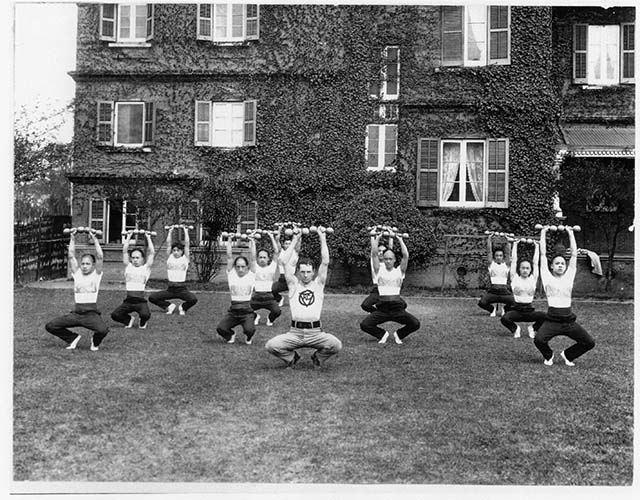
In 1916, Exner investigated “red light districts” at U.S. Army camps along the border with Mexico and spoke with thousands of troops about sex and venereal disease. Later, eight million pamphlets he had written on the topic were distributed by the Army.
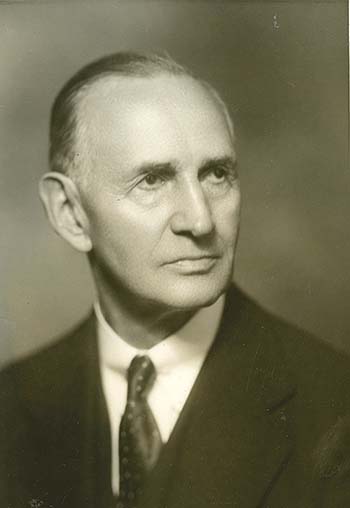
Exner became Director of the Educational Division of the American Social Hygiene Association in New York in 1920, while continuing to write and lecture, with trips abroad to Austria and South America. He was the chief administrator in charge of the venereal disease department at ASHA from 1930-1936, where he worked on his book, The Sexual Side of Marriage, which sold more than one million copies. The Exners then moved to Newark, N.J., where Exner served as epidemiologist in the venereal disease division for the city and directed a model public health clinic. He was in charge of a staff of 60 part-time doctors and full-time nurses and also worked directly with patients, teaching them self-respect and hope.
In an ironic twist of fate, the man who espoused physical fitness all his life endured arthritis of the spine in his later years which produced attacks so severe that he was sometimes forced into immobility and then had to work in a heavy steel corset. His wife wrote, “X-rays had revealed that two discs appeared to be entirely worn away.” Nevertheless, “to keep himself in as good physical trim as possible he took up archery at the age of 68” and became good enough to compete in archery meets.
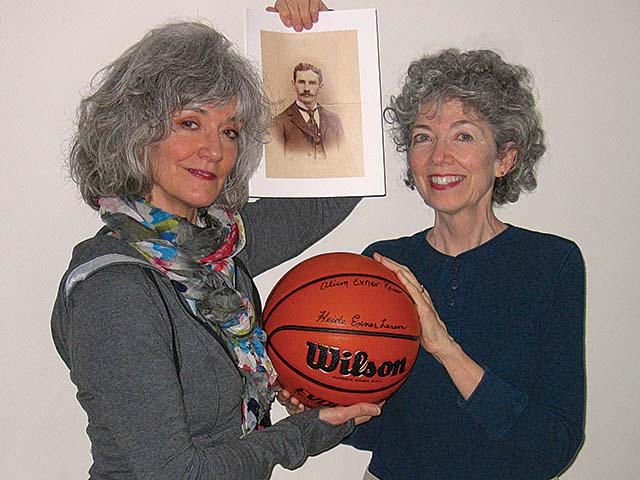
picture of their grandfather Max J. Exner and autographed basketball, Jan. 2013. Photo courtesy of the Exner family.
Beran noted that “only rarely and upon great persuasion would he consent to demonstrate his torch swinging” and his son, Max Vernon Exner, recalled that, on family holidays, “Max would occasionally demonstrate on a dark night with flaming torches,” a display that was “awesome and spectacular.”
Exner died of thrombosis at the age of 72 on Oct. 10, 1943. At his memorial service, Exner was lauded as a pioneer in both physical education and social hygiene.
Exner’s granddaughter, Heide Exner Larson, has no memories of her grandfather, since he died before her birth. But she has a memory of a game passed on down from her grandfather to her father, Max Vernon Exner, which appears to have influenced the game of “basket ball” devised by Max Joseph Exner’s roommate Naismith so long ago.
Glen Taylor, owner of the men’s Minnesota Timberwolves and champion women’s Minnesota Lynx pro basketball teams, is shown with a ball signed by Exner family members at “Links to the Past, Lynx to the Future” event held at Target Center on Sept. 14, 2013. The event was hosted by the Northfield YMCA and the Lynx.
The game was called “Duck on a Rock” and her family played it in a parking lot of a restaurant after closing hours in Ames, Iowa, following an evening of folk dancing at their church and refreshment at this restaurant. Larson told me, “Basically we put a rock on top of another flat rock. Players lined up behind a chalk line, while one person ‘guarded’ the ‘duck’ on the rock. Because they were rocks, the guard had to stay out of the line of fire, while we threw our rock at the sitting ‘duck.’ Our challenge was, once thrown we had to race to retrieve our rock before the guard could tag us. If he did tag anyone, that person became the next guard.” Larson remembers, “There was a certain romance to this game for us, as we played it at night with parking lot lights overhead and soft breezes filling our exercised lungs. The fact that my dad passed the game on to his children suggests this was a fond memory of quality time shared between father and sons.”

“Duck on a Rock” was a game Naismith had played in his childhood in Canada. He had discovered that a soft, lobbing shot worked better than a straight, hard throw for this old game, a concept he worked into the shooting method of his new game. Naismith, who died in 1939, lived to see his game played as an Olympic sport in the 1936 Summer Olympics in Berlin.
A quite amazing legacy exists for Minnesota women’s basketball, stretching back to the very beginning of the sport itself through Naismith, Exner and those Carleton women who first played the game, “eyes sparkling with excitement.”
Thanks to Emily Monaghan, Heide Exner Larson and Carleton Archivist Eric Hillemann for contributions to this column. The story of what happened to the sport after Exner introduced it to the women of Carleton can be found in Daughters of the Game: The First Era of Minnesota Girls High School Basketball 1891-1942 by Marian Bemis Johnson and Dorothy E. McIntyre (2005) and in their fictionalized rendering of this time, Two Rings: A Legacy of Hope (2012). “Basket ball” spread quickly but interscholastic team play faded and was replaced by recreational programs deemed more appropriate. Ele Hansen and Pat Lamb of Carleton’s physical education department were influential in Minnesota in bringing about Title IX in 1972 which prohibited sex discrimination in education.


